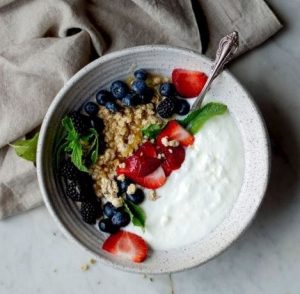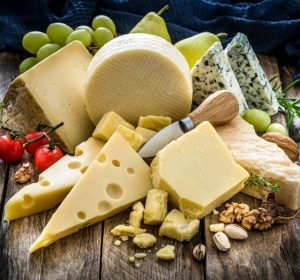Milk in its natural form can last two hours without going bad. Unfortunately, contamination makes it difficult to store milk longer. The only sure bet is preserving it as dairy products. What are dairy products? Dairy products are products made from milk. This may include cow milk, goat milk, camel milk or even buffalo milk. Some of the popular dairy products include yogurt, cheese, milkshake, ice cream, butter and kefir among others.
Healthy milk secreted from a healthy udder is almost sterile. It contains natural inhibitors such as lactoperoxidase and lactoferrin. These inhibitors prevent the rise of bacteria for 3-4 hours after milking. Cooling the milk below 40C maintains the milk in its original form.
Milk refrigeration is not feasible in all parts of the country. Sometimes, milk production exceeds the farms’ refrigeration capacity. At such seasons, the best way to ensure effective milk preservation and dairy profitability would be value addition.
Milk in itself is good enough but what about making a few products out of it! This definitely sounds interesting and digging deeper into some of these Milk products such as cheese, Milkshakes, Yoghurt, and ice cream is all this post is about. Let’s take the scroll together.
1. Yoghurt
What Is Yoghurt?
The basic definition of yoghurt is a semi solid sourish milk product curdled by action of cultures. Yoghurt was accidentally invented decades ago and has recently gained great popularity across the globe.
What’s The Origin of Yoghurt?
 There is the common believe that yoghurt has its origin in Mesopotamia where it was invented thousands of years ago. Around 500 B.C, residents of Mesopotamia had domesticated sheep and goats. These animals were kept for milk and meat and the milk collected was stored in gourds. The warm climatic conditions naturally turned the milk into curd and there you get it, the first form of yoghurt.
There is the common believe that yoghurt has its origin in Mesopotamia where it was invented thousands of years ago. Around 500 B.C, residents of Mesopotamia had domesticated sheep and goats. These animals were kept for milk and meat and the milk collected was stored in gourds. The warm climatic conditions naturally turned the milk into curd and there you get it, the first form of yoghurt.
Yoghurt wasn’t so popular until 30-40 years ago when fruit flavoring of yoghurt came into play. This gave it various flavors and served to be ready made breakfast. This didn’t only warm people’s hearts but also fueled the commercial yoghurt production.
What Are The Benefits Of Yoghurt?
As you may have realized, yoghurt is now in almost every convenient store and comes in various flavors. It has gained popularity not only because of the amazing taste but also for the numerous benefits.
1. Rich supply of probiotics
Yogurt has its origin from milk. This gives it a dose of animal proteins, nutrients such as calcium, vitamin B 12, B 2, magnesium and potassium. This is a combination that is rare to find and that’s not all yoghurt boasts of containing the ‘hard to find’ probiotics.
What are probiotics?
Probiotics can simply be described as friendly bacteria commonly found in fermented foods and are similar to the bacteria found in the body. They are normally found in the lower section of the digestive tract and its estimated that the number of bacteria found in the intestines is higher than a combination of all the bacteria found in the rest of the body.
Probiotics health benefits
I) Balancing of friendly bacteria in the digestive system
The probiotics being ‘good’ bacteria have the ability to restore natural gut bacteria balance. The imbalance is a result of too many bad bacteria and may result from medication, illness or poor diet. In such situations, one tends to have digestive issues, obesity, mental problems and allergies. The probiotics found in yoghurt come in handy in resolving the problem and tends to be the safest way of restoring the balance.
II) Prevention and treatment of diarrhea
One of the side effects of an imbalance in the gut is diarrhea. This is a condition that not only drains the body fluids but also leaves one in severe pain. Studies have shown that 42% of diarrhea associated with antibiotics can be prevented or controlled by the use of probiotics. The Lactobacillus rhamnosus, yeast Saccharomyces boulardii and Lactobacillus casei strains are known to significantly reduce the risk of diarrhea.
III) Improving heart health
Keeping your heart healthy is vital and probiotics make that a possibility. The natural probiotics such as those found in yoghurt play a major role in lowering blood pressure and cholesterol. The bacteria produces lactic acid that breaks down the bile found in the gut thus lowering cholesterol levels.
2. Reduced Allergy and Eczema severity
Eczema is common in children and infants and studies have shown that children fed on yoghurt or probiotic supplemented milk had improved compared to children fed on milk without probiotics. The effect of probiotics is also seen in pregnant mothers who take probiotics as their children tend to have a lower risk (83%) of developing eczema. More research however needs to be done to establish a clear link between eczema and probiotics.
3. Enhancing complexion
Yoghurt has countless benefits on your skin. Whether you will be using it as a face mask on drinking it, you can be sure that the effects will be evident on your skin. It not only makes the skin supple but also radiant.
If you thought wrinkles only come with age, you will be surprised to learn the many reasons behind wrinkled skin. It however needs not bother you as there are numerous solutions and yoghurt may be the ultimate remedy for you. Yoghurt contains lactic acid that comes is handy in skin exfoliation thus making it easy to shed the topmost skin layer that contains unhealthy wrinkled cells. This leaves you with a smooth, elastic and brighter skin.
Well, yoghurt also has a solution to those battling with acne. In addition to the lactic acid, yoghurt also contains a significant amount of zinc. It is this zinc that works magic on acne and applying plain yoghurt daily ensures that the acne doesn’t reoccur. Some skin experts may advice the combination of lemon juice with plain yoghurt to erase acne pigmentation and blemish but you may need to seek advice on the same as we all have different skin and the products will react differently.
4. Prevention of hypertension
In addition to the probiotics, yoghurt contains a notable amount of potassium. Potassium is a potent mineral that has gained popularity among nutritionists and cardiologists for its ability to regulate blood pressure. Potassium helps in the elimination of excess sodium and decreases its re-absorption in the body. Sodium is linked with high blood pressure that results in kidney disorders and hypertension and yoghurt plays the vital role of keeping it in check.
5. Provision of omega-3
Yoghurt has so much to offer and vegetarians have one more reason to stock it, omega 3. Omega 3 fatty acids are very effective in blood sugar regulation, weight loss, cancer prevention, decreased inflammation but is mostly found in animals. This means that vegetarians have limited sources of these vital fatty acids. Lucky enough, yoghurt has enough amounts of these fatty acids. With daily yoghurt intake, one is assured of an adequate supply of omega 3 and the results will be evident.
6. Prevention of yeast infections
Yeast infections are not new especially among women. They are even more predominant in women suffering from diabetes with vaginal infections topping the list. Women suffering from diabetes have imbalanced pH levels and the combination with abundant glucose creates a breeding hub for Candida albicans which is the parasitic fungus responsible for vaginal yeast infections.
The Lactobacillus acidophilus contained in yoghurt is a probiotic bacterium that produces hydrogen peroxide. The hydrogen peroxide destroys yeast and hinders its reoccurrence. For the bacterium to be introduced, one needs to eat yoghurt on a daily basis and also apply it directly to the affected area.
Note: Only use plain yoghurt for yeast infection treatment
2. Cheese
Cheese is normally in its solid form and is produced from proteins and fats from milk. It is one of the milk products that are commonly used in homes and the fact that it can be used in multiple recipes makes it very popular. There has been concerns about the fat and sodium content in cheese making it necessary to have a deeper understanding of cheese.
Types Of Cheese
Cheese can either be used alone as a snack or appetizer or even as an accompaniment to foods such as pizza, burger, sandwich and salads. There are numerous varieties of cheese depending on the flavors, fat content and origin. Some of these varieties include:
1. Reduced fat cheese
This is the cheese that is popularl y known as low fat cheese. It is made with 2% milk making it very healthy. Skim milk or 0% milk is used to make non-fat cheese.
y known as low fat cheese. It is made with 2% milk making it very healthy. Skim milk or 0% milk is used to make non-fat cheese.
2. Whole milk cheese
Just as the name suggests, this is the cheese that contains a considerably high amount of milk. One serving of whole milk cheese contains 6-10 grams of fat per 1 ounce.
3. Fresh cheese
These are the cheeses that are yet to be aged or matured. This is to mean that they have high moisture content, milder in taste and have a soft texture. Some of the cheese that fall in this category include cream cheese, ricotta, mascarpone and cottage cheese.
4. Mature/aged cheese
This definitely would be the opposite of fresh cheese and has a firmer texture, less moisture and sharp taste. The cheese that falls in this category tends to be aged for six months or longer. The cheese gains more flavor and concentration with age. Some of the cheese that will be referred to as aged cheese include Swiss, gruyere, cheddar and parmesan cheese.
5. Processed cheese
This is a category that may not necessarily contain cheese in its original form and the products in this category aren’t referred to as cheese. Such products include American cheese, cheese flavored and cheese food. These are not categorized as cheese as they are shelf stable products with ingredients such as emulsifiers and flavor enhancers.
6. Non-dairy cheese
Cheese is commonly made from dairy products but it’s not every type of cheese that will contain dairy products. Cheese such as daiya and soy cheese are non-dairy varieties. They are an excellent choice for individuals who wouldn’t prefer taking dairy products.
Cheese Benefits
Just like other dairy products, cheese has numerous health benefits most of which are inherited from milk. These benefits include;
I) Bone health
Cheese contains vitamins A, K and D, calcium, zinc, magnesium and proteins that play a major role in bone development. There is the fear that dairy products contain high acid levels which is a risk to bone health but there is no scientific evidence to justify that. Cheese thus remains to be a great option bone strengthening.
II) Dental Health
The calcium contained in cheese contributes to dental health by enhancing teeth and gum strength. Calcium is vital in teeth formation and also ensures that teeth remain healthy and strong. Studies have also shown that cheese can raise the dental plague pH which means that the teeth will be protected from dental cavities.
III) Omega 3 fatty acids
Some types of cheese, especially those from cows fed on alpine grass, have been known to contain a lot of omega 3 fatty acids. These fatty acids are of great benefits to the body as they help fight cardiovascular related diseases.
IV) Regulating blood sugar
Despite cheese being rich in sodium and fats cheese lovers have been known to have low blood sugar. This is because cheese contains calcium that considerably lowers blood sugar. It is however advisable that one goes for the low-sodium, low-fat cheese such as Swiss cheese to be on the safe side.
3. Milkshake
A milkshake is served cold. It’s a sweet beverage made from ice milk, ice cream or milk. Milkshakes will add value to your milk and sweeten your dairy profits.
Milkshakes are common across the globe. The name used may vary from one region to the other. In the United States, a thick shake or thick milkshake refers to milkshake made from ice milk or ice cream. The same product is known as frappe in New England.
Types of milkshakes
 Milkshakes can take different forms and shapes. Everyone wants to personalize their shake to suit their taste buds. Some of the common types of milkshakes that are popular across the globe include;
Milkshakes can take different forms and shapes. Everyone wants to personalize their shake to suit their taste buds. Some of the common types of milkshakes that are popular across the globe include;
1. Pre-made milkshake
These types of milkshakes are available in stores. They are ready made and may come in different flavors. Most of the common shakes are made from a mix of milk, sweeteners, flavored concentrate and carrageenan thickener.
2. Hand blend or homemade milkshake
Traditionally, milkshakes were made from home. This was until retail shops introduced premade milkshakes. Well, homemade ice cream is still popular.
Homemade milkshake gives you the opportunity to tweak your ingredients. This is very important to individuals who want to watch their weight or those on a healthy diet. You have the freedom to add all that you want to make the milkshake healthy and tasty.
Milkshake health benefits
I) Calcium for strong and healthy bones and teeth
Milkshake, especially those made from milk products, a packed with calcium. A single cup of the milkshake may contain up to 300g of calcium. This is a generous supply of the precious mineral salt.
Calcium is very important in bone and teeth formation. With a constant supply of the calcium from milkshakes, you will be guaranteed of healthy and strong bones and teeth. You will not only have the coveted grin at old age but will also have the freedom to eat even the toughest foods at old age.
II) Appetite boost
Loss of appetite has been a bother for many people. Intake of drugs and medication tends to suppress one’s appetite and this may affect the overall health negatively. Milkshakes come in handy to boost appetite.
Traditional foods can be boring or hard to take in especially for individuals suffering from chronic illnesses such as cancers. The inclusion of milkshakes in diets lets them enjoy a healthy yet tasty meal.
Milkshakes will supply the much needed calcium, protein, potassium, fat and iron among other vitamins and mineral salts. This is not to mention that the shakes are sweets and will be appealing to all.
4. Ice cream
It may not first strike you as a dairy product but ice cream is a dairy product. The soft frozen food is made from milk and cream and can be flavored with fruit or vanilla to give it that delicious taste. Ice cream traces its origin in Egypt and Mesopotamia where drinks with ice were serve to the rich and those in power.
Types of Ice Cream
1) Hard/Ordinary ice cream
 The commonly known ice cream cross the globe is the hard ice cream. This is the ice cream made of 10% milk fat, 12 to16% sweeteners, sugar, eggs, cream and stabilizers. It can either be served plain or with toppings that have ensured that it remains relevant in the ever changing industry.
The commonly known ice cream cross the globe is the hard ice cream. This is the ice cream made of 10% milk fat, 12 to16% sweeteners, sugar, eggs, cream and stabilizers. It can either be served plain or with toppings that have ensured that it remains relevant in the ever changing industry.
2) Reduced-fat ice cream
Many people keep off ice cream for the fear that they will add on weight. What they do not know is that it’s not every type of ice cream that is unhealthy. Reduced fat ice cream is one of the healthy ice cream options. This type of ice cream contains low-fat ingredients and low sugars making them a great option for those on a diet.
3) French ice cream
This ice cream coins its name not only from its popularity in France but also from its ingredients. It is a unique summertime treat as it includes whole eggs or egg York, milk, and cream.
4) Light ice cream
Just as the name suggests, this type is slightly different as its base contains 25% less milk fat. It would be a good option for those looking for considerably lean options.
Ice Cream Benefits
Ice creams make our summers bearable and memorable. On top of that, they bring along so many benefits that you can’t resist to have a bite. These benefits include;
I) Provision of energy
Ice cream has nutritional value and also serves as a great source of energy. It is rich in fats, carbohydrates and proteins which are essential in provision of energy in the body. It is a great option for those who need instant energy boost especially for those with diabetic conditions. You only need to be careful on the amount of ice cream you are taking as too much of it can see you gain unwanted weight.
II) Source of vitamins
Ice creams are packed with a number of essential vitamins such as Vitamin A, B-12, B-6, D, C and E. On top of that, it also contains vitamin K that aids in blood clotting. Studies have also shown that it also contains thiamine, riboflavin and niacin.
III) Source of minerals
Milk products are known to be rich in minerals and ice cream is no exceptional as it contains phosphorous and calcium. Calcium plays a major role in bone development and also reduces chances of kidney stones development.
IV) Brain stimulation
The ultimate goal of every human being is to be happy and ice cream has the secret behind happiness. Ice cream is known to stimulate the hormone thrombotonin, hormone of happiness, which keeps one’s moods on a high note. A constant intake of ice cream will guarantee you stress free days and a desirable social life.
How To Make Ice Cream
Ice cream making is not as complicated as some people tend to think. It is particularly very simple if you have an ice cream maker. You however need not worry if you do not have an ice cream maker. There are dozens of recipes that do not require an ice-cream maker.
There are several options that will serve as yogurt maker alternatives. These include;
Home-Made Ice Cream Made In Bags
Freezer bags will go a long way in aiding you make ice cream with ease. Simply pour the ice cream base in the bag. Mix with sweetened condensed milk and heavy cream. Pour in rock salt and ice into the bag and seal it. Shake for 10-15 minutes. Your ice cream making process will be over.
Hand Blended Ice Cream
If you have a hand-held whisk, food processor or a high-powered blender you are on your way to making creamy ice cream treats. Mix the ice cream base and pour into a freezer bag.
Break your frozen cream base into large pieces and place them in the blender. If using a whisk, place in a bowl. Blend the mixture to achieve a smooth tasty treat.
The above methods should help you make delicious home-made ice cream with ease. You can also check out of publication on how to make ice cream for more insight.
Conclusion
Milk is naturally rich in nutrients and can significantly contribute to a healthy lifestyle. Whether served as milk or as one of the milk or dairy products it still remains to be a very rich diet and diet supplement. With the many forms of milk preservation now available to you, you can now preserve milk in its natural milk form or as cheese, ice cream or yoghurt which are very healthy options too. You just have so much to experiment with milk and its products.
